Aswathy Chandrakumar, Priyanka Singh, R P Dwivedi and A K Handa from the ICAR-Central Agroforestry Research Institute participated in the webinar “Developing grassroots level extension mechanism and capacity building of rural youth for upscaling agroforestry” by ICAR-Central Agroforestry Research Institute (CAFRI) on 9 November 2020 and they share their experiences here.
CONTEXT
Agroforestry is emerging as a sustainable land use option for livelihood security and climate change mitigation. Though agroforestry is an age-old practice, efforts to mainstream it are fairly recent. Extension interventions play a key role in stimulating agroforestry activities and therefore, it becomes imperative to build and strengthen agroforestry extension. With several extension models available, the choice depends on existing constraints in agroforestry development and the model’s appropriateness to a given set of local conditions. With this background, Food and Agriculture Organisation (FAO), ICAR-Central Agroforestry Research Institute (ICAR-CAFRI) and National Rainfed Area Authority (NRAA) developed a technical cooperation project to support implementation of National Agroforestry Policy (NAP) for enhancing tree and forest cover and for improving wood quality production.
Against this background, ICAR-CAFRI, AICRP on Agroforestry in collaboration with NRAA and FAO organized a webinar “Developing grassroots level extension mechanism and capacity building of rural youth for upscaling of agroforestry” on 9 November, 2020. The main aim of this webinar was to engage various stakeholders in deliberations about developing suitable extension mechanisms for taking agroforestry to the last mile. Along with FAO representatives, speakers from both public and private organisations took part in the webinar to share their experiences in upscaling promising agroforestry models. A total of 115 participants participated.
INTRODUCTORY SESSION
The welcome address was given by Dr. R K Tiwari, Director (A) ICAR-CAFRI. Following the welcome address, Dr. S K Chaudhari, DDG, (NRM), ICAR, emphasised linking farmers to markets, developing value chains in agroforestry and capacity building as various viable options to take agroforestry forward. Dr. A K Singh, DDG, (Extension), ICAR also emphasized the need to carry out agroforestry practices in a more organized manner. Additionally, he reflected on processing and commercialization, which are as important as production in upscaling agroforestry development in the country. Distribution of quality planting materials, laying out demonstration plots in the campus and increasing the role of Krishi Vigyan Kendras (KVKs) in carrying out agroforestry extension were other areas he emphasised. In his address, Dr. S Bhaskar, ADG, (Agronomy, AF and CC), NRM, ICAR, concluded that quality nurseries play a pivotal role in successfully implementing any agroforestry model. Also, he urged the need to implement buyback system in public-private partnership mode.
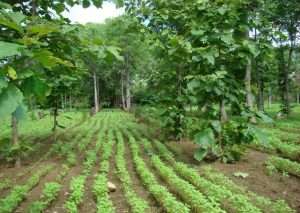 Teak Based Agroforestry System-Advocating Har Medh Par Ped for ensuring sustainable livelihood and promoting climate resilient farming systems.
Teak Based Agroforestry System-Advocating Har Medh Par Ped for ensuring sustainable livelihood and promoting climate resilient farming systems.
EXPERIENCE SHARING
Indian Council for Forestry Research and Education (ICFRE)
In his opening remark, Dr. Sudhir Kumar, DDG (Extension), Indian Council of Forestry Research and Education (ICFRE), underscored the role of agroforestry in increasing forest cover and how it plays a crucial role in augmenting livelihood opportunities. He also recounted that in their efforts to promote poplar based agroforestry system in Vaishali and nearby districts of Bihar, farmers were involved in the establishment of Kisan Nursery. He highlighted establishment of model nurseries, demonstration centres, conducting capacity building programmes for the farmers through kisan study tour and trainings, and facilitating plantation as some of the key drivers for upscaling poplar based agroforestry system in Bihar.
ITC in extension of agroforestry
Dr. Sunil Pandey, Vice President, ITC, discussed how they promoted sustainable agroforestry for wood and food security. Their main emphasis was on tree improvement programme for reducing dependence on forests for industrial wood. Their focus was mainly on genetic improvement of planting stock and improvement in package of practices, which resulted in development of eucalyptus clones with higher productivity, yielding 35-40 cubic meter per hectare per year. Through this initiative, 90 per cent of their raw material could be procured through agroforestry. According to him, the four pillars of agroforestry development are government, industry, pricing and research institutions. Government should promote favourable policies and industries should rely on agroforestry models for procuring raw material. Better pricing for farmers, assured market, increased R and D investments by research organization and outreach activities through KVKs and local collectives like Farmer organisations are crucial for the development of agroforestry, he noted.
Extension module for implementation of National Agroforestry Policy 2014 and its best practices
Smt. Anita Arakkal, Additional Principal Chief Conservator of Forests (APCCF), Karnataka, and Sh. Ram Kumar (APCCF), Gujarat, were invited to deliberate on this topic. Based on their involvement in community forestry projects, they emphasized the need to recruit motivated manpower for extension activities. Also, establishment of Kisan nurseries, Mahila nurseries, organizing van Mahotsav programme to supply quality planting material at nominal charges have helped in upscaling agroforestry practices in Gujarat. They concluded that since no set extension module has been developed, it is important to review current extension and communication mechanism and develop an extension module for promoting agroforestry activities across the country.
Extension mechanism of wood based industries for plantation activities at the field level
Sh. Naval Kedia, President, Federation of all India Timber Merchants Saw Milers & allied Industries, urged researchers to focus on softwood. He opined that growing of pines will fetch more foreign exchange and it is time that research and development activities be reoriented around pinewood as very limited research is being taken up on promoting pinewood for packaging in India.
Upscaling agroforestry activities by Bharatiya Agro Industries Foundation (BAIF)
Mr. Yogesh Sawanth, Programme Coordinator, BAIF, Pune, made a detailed presentation on the Wadi programme adopted by the organization. It was conceived as a holistic tree-based climate resilient farming system ensuring sustainable livelihood and food security. Thrust was given to cluster based planning, farmers’ exposure visits, training and demonstrations, mobilizing youth in value addition, forward and backward integration to promote agroforestry activities. Most of their extension activities are carried out through trained community resource persons.
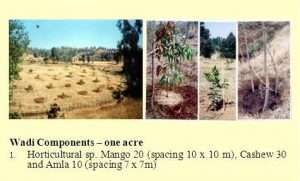 Design of Wadi programme
Design of Wadi programme
| Wadi programme implemented by BAIF Wadi means orchard in Gujarati and this approach aims at holistic development of rural areas through the promotion of agroforestry. A typical wadi plot comprises of 0.4 ha area and is an agri-horti-forestry arrangement of beneficial plant species. Through this programme, small and marginal farmers were targeted to convert degraded land resources into productive assets by integrating trees into farming system. The key components of this programme include natural resource management, community mobilization, capacity building, women empowerment, post-harvest processing and handling, community health, drinking water and hygiene. The impacts of this programme are- 1. Implemented in an area of 80,900 ha of wastelands involving more than 0.2 million tribal families, Wadi programme was able to generate Rs. 10 billion income. 2. It resulted in the socio-economic development of rural people, ensuring sustainable livelihoods. The programme was also able to mobilise youth by actively engaging them in post-harvest processing and handling activities. 3. This programme helped in converting degraded lands into productive resources using the participants’ own labour as a major input. |
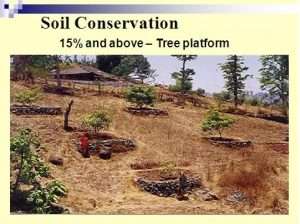 Soil conservation under wadi program
Soil conservation under wadi program
Consortium mode for upscaling agroforestry
Considering the growing demand of wood and wood products, Tamil Nadu Agricultural University (TNAU) implemented a ‘value chain model’ to ensure sustainability in generation of industrial wood and its supply in the state. Later, a “Consortium of Industrial Agroforestry”, CIAF, was established to align with the objectives envisaged in the National Agroforestry Policy of 2014 with a view to address issues related to production, processing and consumption of agroforestry. In his address, Dr. K T Parthiban, Dean, Forest College and Research Institute (FCRI), Mettupalayam, elaborated how this model resolves various issues in the production-consumption system of agroforestry. He further elucidated various activities of CIAF, which includes production of quality planting material through decentralized institutions, capacity building of plantation developers, establishment and monitoring of harvesting and marketing institutions, development of price supportive mechanisms, value addition technologies, tree insurance and other research initiatives. He also urged policymakers to implement consortium mode of agroforestry at the national level, as it is a promising model to meet raw material demands of the industry while keeping in view climate change.
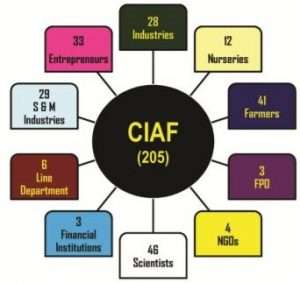 Consortium of Industrial Agroforestry
Consortium of Industrial Agroforestry
Upscaling agroforestry in coffee plantations
Dr. C G Kushalappa, Dean, College of Forestry, Ponnampet, shared his experience on how integrating agroforestry practices in coffee plantations helped in improving the livelihood security of coffee growers of Kodagu district. With the help of funding from the European Union, some key activities undertaken in this project were participatory documentation of the ecosystem, ensuring better access to markets and eco-certification schemes, information dissemination on coffee agroforestry systems and in formulation of guidelines for sustainable coffee cultivation integrating agroforestry practices. In his concluding remarks, he also highlighted the success of Krushi Aranya Protsahana Yojana (KAPY) that is being implemented by the Karnataka Forest Department and termed it a win-win strategy to promote tree-based agriculture.
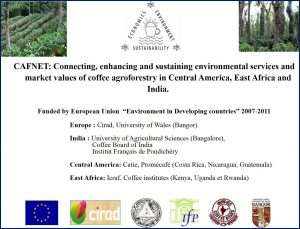 International Collaborative project on agroforestry in Coffee
International Collaborative project on agroforestry in Coffee
| Krushi Aranya Protsahana Yojana (KAPY) This scheme was implemented by Karnataka Forest Department in 2011-12 as an effort to encourage cooperation of farmers and general public in the task of increasing the area under tree and forest cover. Under this initiative, seedlings are distributed to farmers at subsidized rates and an incentive of Rs. 30, Rs. 40 and Rs. 30 is given to farmer for every survived seedling at the end of first, second and third year, respectively. This incentive based approach encourages farmers to raise and nurture seedlings on their farm for at least three years. This flagship programme of the Karnataka forest department has received good response in the state. |
Scope of credit support for encouraging agroforestry as a profitable enterprise
Sh. Vinod Arya, DGM, NABARD Regional office, Lucknow, was invited to reflect on the topic. He emphasized how credit support to farmers can help in promoting agroforestry and also how integrating trees in their farms will result in investment credit.
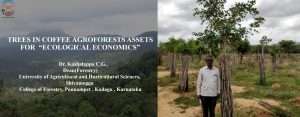 Presentation of Dr. Kushalappa in the webinar / Krishi Aranya Protsahana Yojana (in field)
Presentation of Dr. Kushalappa in the webinar / Krishi Aranya Protsahana Yojana (in field)
FEEDBACKS FROM PROGRESSIVE FARMERS
Two progressive farmers were invited for the webinar.
Sh. Amrik Singh from Chandigarh expressed his concerns on the quality of planting material. He emphasized the importance of certification of seeds/ tree saplings and urged policymakers to develop international standards for plywood that needs to be followed for exporting by farmers. He was also happy to share his experience on growing Melia dubia and Melia composite for timber production as the yield was good.
Sh. R Ganesan, a tree culturalist and policy analyst from Tamil Nadu, explained how his degraded land was converted into a productive asset through the cultivation of Red Sanders. Through the incorporation of agroforestry techniques on his land, he stressed, there was a visible increase in rainwater percolation and improvement in soil health within 4-5 years. He highlighted the need to conserve endangered tree species and to incentivize soil carbon in a way Germany does. Also, the need for policy research and increasing the role of Timber Development Board were his other suggestions.
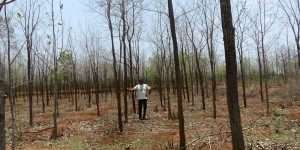 Sh. R Ganesan in his Red Sanders land in Tamil Nadu
Sh. R Ganesan in his Red Sanders land in Tamil Nadu
CONCLUDING REMARKS
Following a brief discussion with the participants, Dr. Ashok Dalwai, CEO, National Rainfed Area Authority (NRAA), summarized and concluded the webinar. The key take-home messages as articulated by Dr. Dalwai were-
- Build on existing extension mechanisms. There is a need to compile the lessons learnt from all possible models and develop a practice guide.
- Strengthening and empowering farmer collectives and self-help groups to carry out participatory technology development and in developing location specific agroforestry models.
- Introducing incentive based approaches to encourage agroforestry adoption among farmers.
- Increasing the role of KVKs in agroforestry related extension. A subject matter specialist post must be created for forestry professionals and they must be engaged in flow of information and knowledge. They should also be entrusted with the responsibility of implementing agroforestry activities in their jurisdiction.
- Initiating agroforestry pension scheme and minimum support price mechanism can foster agroforestry development in the country.
- Linking farmers to markets is an important step in promoting agroforestry as a profitable enterprise.
- Investing in youth and strengthening human capital can help in promoting agroforestry in the future. Training them to become entrepreneurs and approaching agroforestry from a value chain perspective is promising.
- Linking multiple institutions (public-private-NGOs-community based organisations) at district or state level can help in formulation of tailor-made extension modules addressing different target groups.
OUR IMPRESSIONS
Grassroots level extension has an important role in promoting agroforestry across the country. Various extension models used by public, private, NGOs and other organisations are prevalent in across India. However, no systematic effort has been done to review, discuss and document these initiatives.
This webinar provided a platform to gain insights into various agroforestry extension mechanisms implemented in different parts of India. It also facilitated exchange of new and innovative ideas for promoting agroforestry activities. The participants showed great enthusiasm in sharing their experiences, the lessons learnt and in discussing the way forward to taking agroforestry to the last mile.
Realizing the power of such virtual media to connect with larger audience, it is strongly desired that quality discussions of this nature be encouraged. Webinars can act as brainstorming platforms, catalysing the formulation of state specific or area specific extension modules to carry out agroforestry activities in this new normal.
The authors are with the ICAR-Central Agroforestry Research Institute, Jhansi, Uttar Pradesh, India.
 Mrs. Aswathy Chandrakumar, is Scientist (Agricultural Extension), email: aswathy.c@icar.gov.in
Mrs. Aswathy Chandrakumar, is Scientist (Agricultural Extension), email: aswathy.c@icar.gov.in
 Dr. Priyanka Singh is Scientist (Agricultural Economics), email: priyanka.singh@icar.gov.in
Dr. Priyanka Singh is Scientist (Agricultural Economics), email: priyanka.singh@icar.gov.in
 Dr. R P Dwivedi is Principal Scientist (Agricultural Extension) email: Raghunandan.Dwivedi@icar.gov.in
Dr. R P Dwivedi is Principal Scientist (Agricultural Extension) email: Raghunandan.Dwivedi@icar.gov.in
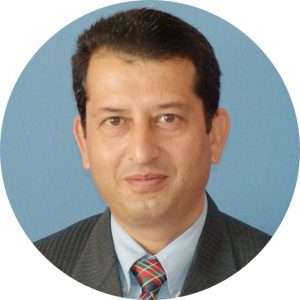 Dr. A K Handa, is Principal Scientist (Forestry) email: Arun.Handa@icar.gov.in
Dr. A K Handa, is Principal Scientist (Forestry) email: Arun.Handa@icar.gov.in

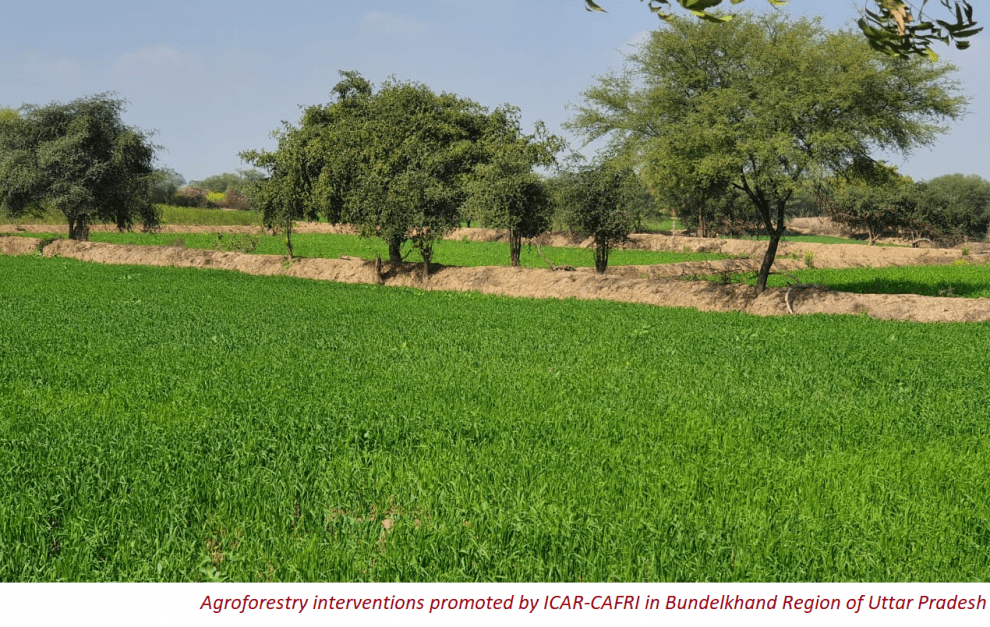

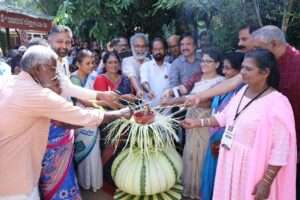

Add Comment